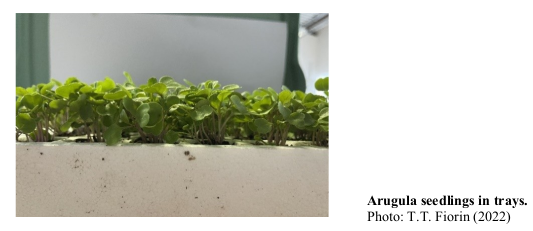Effect of different sowing densities and substrates on the growth of arugula seedlings

Abstract
Arugula is known for the spicy flavour of its leaves, and it is an important crop due to its high productivity and multiple harvests per year. However, seedling quality may limit its production. This study examined arugula seedling emergence and production at different sowing densities and substrate compositions. In a greenhouse, the broadleaf cultivar was randomized with a 5×3 factorial design (substrate compositions: 100% medium textured sand (SD), 100% Carolina Soil® commercial substrates (CS), 50%SD+50%CS, 75%SD+25%CS, and 25%SD+75%CS, and sowing densities: 5; 10 and 15 seeds/alveolus); with five replications. Analyzes were carried out on emergence speed index and mean emergence time, as well as on relative frequency, lengths of aerial and root parts, number of leaves, and rating scales according quality for tuft formation (or bouquets) and clod stability. All seeding densities and substrate compositions showed good seedling formation, except for the 100% SD composition, which showed low adherence in the substrate-plant-container-water system for tuft formation and clod stability. Except for 100% SD composition, an average of 70% of seedling emergence was at 9.7 d. For the production of commercial seedlings, it is indicated the use of 10 or more seeds per alveolus, and all substrate compositions tested in this study, except 100% SD.
Keywords
Eruca vesicaria subsp. sativa (Miller) Thell., Formation of tufts, Clod structure, Seedling production
References
- Al-Taey, D.K.A. and Z.J.M. Al-Musawi. 2022. The impact of nano fertilization and salicylic acid on growth, yield and anti-oxidant contents in rocket plant under salt stress. Agraarteadus J. Agric. Sci. 33(1), 43-47. Doi: https://doi.org/10.15159/jas.22.10
- Alvares, C.A., J.L. Stape, P.C. Sentelhas, J.L. Moraes Gonçalves, and G. Sparovek. 2013. Köppen’s climate classification map for Brazil. Meteorol. Z. 22(6), 711-728. Doi: https://doi.org/10.1127/0941-2948/2013/0507
- Brasil MAPA, Ministério da Agricultura, Pecuária e Abastecimento. 2012. Portaria SDA/MAPA 111/2012 (D.O.U. 05/09/2012). Brasilia.
- Ferreira, D.F. 2014. Sisvar: A guide for its bootstrap procedures in multiple comparisons. Ciênc. Agrotec. 38(2), 109-112. Doi: https://doi.org/10.1590/S1413-70542014000200001
- Filgueira, F.A.R. 2013. Novo manual de olericultura: agrotecnologia moderna na produção e comercialização de hortaliças. 2nd ed. UFV, Viçosa, Brazil.
- Fiorin, T.T., J.F. Menegaes, and U.R. Nunes. 2021. Substratos para testes de emergência de plântulas de alface sob sistema semi-hidropônico. pp. 74-83. In: Menegaes, J.F. and T.T. Fiorin (Org.). Olericultura: foco em pesquisa da produção de mudas ao processamento. E-Publicar, Rio de Janeiro, Brazil.
- Fiorin, T.T., J.F. Menegaes, A.M. Rodriguez, and A. Swarowsky. 2022. Broccoli and cauliflower seedling emergence and production in diferente substrates. Rev. Colomb. Cienc. Hortic 16 (2), e14339. Doi: https://doi.org/10.17584/rcch.2022v16i2.14339
- Furbeck, S.M., F.M. Bourland, and C.E. Watson. 1993. Relationship of seed and germination measurements with resistance to seed weathering cotton. Seed Sci. Technol. 21(3), 505-512.
- Kämpf, A.N., R.J. Takane, and P.T.V. Siqueira. 2006. Floricultura: técnicas de preparo de substratos. Tecnología Fácil 19. LK Editora, Brasilia.
- Labouriau, L.G. and M.E.B. Valadares. 1976. On the germination of seeds Calotropis procera (Ait.) Ait.f. An. Acad. Bras. Cienc. 48(2), 263-284.
- Maguire, J.D. 1962. Speed of germination: Aid in selection and evaluation for seedling emergence and vigor. Crop Sci. 2(2), 176-177. Doi: https://doi.org/10.2135/cropsci1962.0011183X000200020033x
- Menegaes, J.F., T.T. Fiorin, and A.M. Rodrigues. 2020. Emergência de plântulas e produção de mudas de couve-flor em diferentes substratos e regime de irrigação. Acta Iguazu 9(4), 109- 117. Doi: https://doi.org/10.48075/actaiguaz.v9i4.25881
- Menegaes, J.F., A.P. Zago, R.A. Bellé, and F.A.A.L. Backes. 2017. Enraizamento de estacas de forrações ornamentais em diferentes concentrações de ácido indolbutírico. Nativa 5(5), 311-315. Doi: https://doi.org/10.31413/nativa.v5i5.4468
- Nassif, S.M.L. and S.C.J.G. Perez. 2000. Efeito da temperatura na germinação de sementes de amendoim-do-campo (Pterogyne nitens Tul.). Rev. Bras. Sementes 22(1), 1-6. Doi: https://doi.org/10.17801/0101-3122/rbs.v22n1p1-6
- Oliveira, J.L.B. 2012. Cultivo hidropônico de rúcula. In: Santos, O.S., E.F.R.Q. Melo, and J.F. Menegaes (Org.). Cultivo hidropônico. UFSM, Santa Maria, Brazil.
- Purquerio, L.F.V., L.A.R. Demant, R. Goto, and R.L.V. Boas. 2007. Efeito da adubação nitrogenada de cobertura e do espaçamento sobre a produção de rúcula. Hortic. Bras. 25(3), 464-470. Doi: https://doi.org/10.1590/S0102-05362007000300028
- Rodrigues, L.R.F. 2002. Técnicas de cultivo hidropônico e de controle ambiental no manejo de pragas, doenças e nutrição vegetal em ambiente protegido. FUNEP, Jaboticabal, Brazil.
- Santos, O.S., E.F.R.Q. Melo, D.P. Basso, J.F. Menegaes, A. Cargnelutti Filho, J.E. Filipetto, and R.C. Luz. 2011. Produção de cinco cultivares de rúcula em duas soluções hidropônicas. Bras. Agrociência 17(4), 468-472.
- Sediyana, M.A.N., E.F. Martins, and C.L.O. Pinto. 2019. Rúcula (Eruca sativa). In: Paula Júnior, T.J. and M. Venzon (eds.). 101 culturas: manual de tecnologias agrícolas. 2nd ed. EPAMIG, Belo Horizonte, Brazil.
- Takane, R.J., S.S. Yanagisawa, and E.A. Góis. 2013.Técnicas em substratos para a floricultura. Expressão Gráfica, Fortaleza, Brazil.
